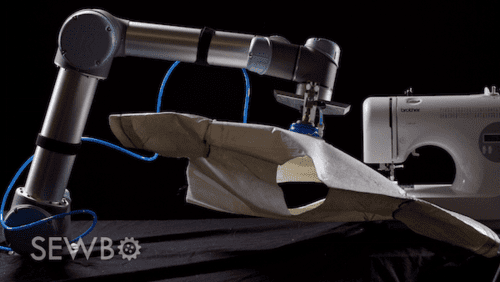
07/25/2017
Clothing manufacturers would love to economize on production with some sort of automation, but the materials used, which vary widely in terms of thickness, stretch, slickness and other qualities do not easily fit into the robot factory. The dexterity and sensitivity of the human hand has kept sewing in the human realm except for simple tasks like hemming, though not for lack of trying.The latest contestant in the sewbot competition uses a clever approach: Seattle developer Jonathan Zornow has changed the material rather than the machine. He has created a process that will temporarily stiffen the fabric to be like a piece of cardboard, which can then be handled by a robot which inserts it into a sewing machine.

The Financial Times’ report on the subject, included below, is sensitive to the wider social implications. Garment production is a big industry in cheap labor havens like Asia and Central America, and the loss of millions of jobs to automation would be devastating. Revolutions have been fought over less.
I wrote about some of those issues in a recent issue of the Social Contract: How Automation Threatens Third World Stability.
And we know that widespread unemployment and consequent social unrest in less prosperous regions can spur mass migrations of persons in search of a first-world welfare office.
Robots and the World of Work, Financial Times, July 18 2017ANNA NICOLAOU, FINANCIAL TIMES: Robots have transformed production of cars and planes. But the garment industry has stayed old fashioned. For decades, companies have tried to sew clothing with a robot. But the concept has mostly remained a pipe dream.
In practise, almost all of the world’s t-shirts and jeans are still made by millions of cheap workers, mostly women watching over sewing machines. The first sewing robots that have been brought to the market are expensive, running in the hundreds of thousands of dollars. With an abundance of cheap labour available in Asia, humans still make more financial sense.
But labour costs are rising in China, and political groups are campaigning to bring jobs back to the US. A new group of start-ups is now looking to upend the way clothing is made.
RAVJ KUMAR, DIRECTOR PAHLE INDIA FOUNDATION: Technology can now replace human beings in their totality, just changing basic motor force, or basic routine mental processes, but has now the potential of, with the huge amount increase in computer power, to replace or substitute complex mental and complex intelligent processes.
NICOLAOU: Jonathan Zornow, a software developer from Seattle, last year came up with what he thinks is the solution. He calls it the Sewbo. Unlike his predecessors, he wants to change fabric to work with robots, instead of vice versa.
He patented a process of drenching fabric in a liquid thermoplastic solution. It makes material like cotton as stiff as a board. The robot then sews, stitches, and shapes the fabric. Wash it off with warm water, and it comes back to life, as a t-shirt or a pair of jeans. With this method, he believes he’s made the first fully robotic garment– a t-shirt.
Mr. Zornow is now in talks with big retailers and manufacturers across China, India, and Sri Lanka to roll out the technology.
JONATHAN ZORNOW, FOUNDER OF SEWBO: This is an industry that’s very dependent on manual labour. And because of this, the supply chains have grown very long. They’ve stretched all the way around the world. I believe the average t-shirt has about 20,000 miles on it by the time it reaches the consumer, going from the cotton field, to the spinning factory, to the textile mills, to the sewing factories.
This allows people to shorten their supply chains to manufacture in a much more responsive way, and to avoid labour costs. So this is something that’s been of great interest to both American retailers and brands, as well as existing manufacturers overseas.
NICOLAOU: But economists are now wondering if these technologies will threaten the entire economic model of South Asia. As Chinese workers demand higher wages, places such as Bangladesh and Pakistan are hoping that their cheap workforces will become the world’s new workshop. The World Bank estimates South Asian countries will add more than one million workers each month for the next two decades.
Economists call this a demographic dividend, as populations grow and wages stay about a quarter of those in China. But if technology like the Sewbo take off, the jobs they’re relying on could be eliminated for good.
KUMAR: So the fear is that our so-called demographic dividend could turn into a demographic nightmare, because of all the educated, aspiring young people who would be unemployed as a result of this automation ad robotisation.
NICOLAOU: The question becomes, how much time is life? Even some of the companies building the robots say it could be 20 years before they’re adopted widely. This would give governments time to prepare, to retrain workers. But some economists warn that these countries should give up on manufacturing altogether, as the demographic nightmare looms. Anna Nicolaou, Financial Times, New York.
This is a content archive of VDARE.com, which Letitia James forced off of the Internet using lawfare.